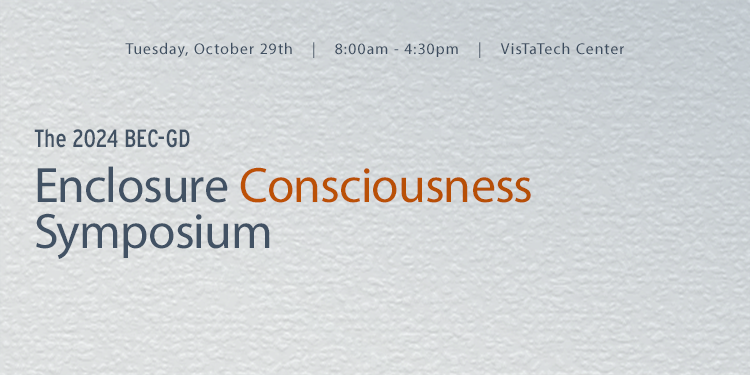
September 17, 2024
BEC-GD 2024 Enclosure Consciousness Symposium
The Building Enclosure Council of Greater Detroit is proud to celebrate their Symposium with you again. For each Symposium, the BEC-GD symposium presents a distinguished panel of speakers to discuss the current and upcoming trends in building enclosure performance and evaluation.
The event includes a continental breakfast, lunch, and snacks. As in previous years, there will be Continuing Education Credits and a raffle for prizes for attendees who visit all of the vendors and obtain a signature from each.
AIA Detroit will provide up to 5 AIA Health, Safety, and Welfare (HSW) Learning Units.
AGENDA:
8:00 am Check-in, Continental Breakfast, Sponsor Displays
8:30 am Opening Comments
8:45 am Presentation 1 – Michael Repka
10:00 am Morning Break, Sponsor Displays & Announcements
10:30 am Presentation 2 – Andrea Wagner Watts
11:45 pm Lunch Break, Sponsor Displays & Announcements
1:15 pm Presentation 3 – Renae Kwon & Josh Hakimian
2:30 pm Afternoon Break, Sponsor Displays & Announcements
3:00 pm Presentation 4 – Melissa Payne
4:15 pm Closing Remarks and Door Prizes
PRESENTATION & SPEAKER INFO
Successful Air Barrier Installation – A Case Study
Michael Repka | Architect, LEED AP Quality Manager at Hoffman Construction
Presentation Description:
The mass timber Founders Hall project at the University of Washington stands as an exemplary model for air barrier performance in design and construction. This presentation will delve into the innovative strategies and collaborative approach that led to the project’s exceptional success, with a focus on how attendees can apply these lessons to their projects.
Learning Objectives:
1. Understand how early preconstruction activities can impact later installations
2. Describe three approaches to achieving good air barrier testing outcomes
3. Understand air barrier testing criteria and codes
4. How to define, construct, and evaluate mockups for maximum benefit of the building envelope execution
 Michael Repka joined Hoffman Construction Company 16 years ago after practicing architecture for 10 years in Seattle and the surrounding area. In his years of practice, he developed the firm’s Quality Plan and executed internal Quality Reviews as a Project Architect, Project Manager, and Partner.
Michael Repka joined Hoffman Construction Company 16 years ago after practicing architecture for 10 years in Seattle and the surrounding area. In his years of practice, he developed the firm’s Quality Plan and executed internal Quality Reviews as a Project Architect, Project Manager, and Partner.
After joining Hoffman Construction in 2006, he worked on project sites coordinating subcontractors and installations, learning all the ways the details he had drawn as an architect were actually being installed. His architectural background and consistent focus on quality made him an ideal Quality Manager; first on project sites, and now corporately, helping to devise and implement a company-wide Quality system. He believes planning is the key to Quality and is focused on Design Document Reviews in preconstruction as the earliest opportunity to control Quality on the construction site.
Michael has experience in many building types, high rise towers to below-grade transit stations, and with GCCM and Design-Build project delivery methods, as both an architect and contractor. A proud building science and sustainability geek, he completed the design and build of his own net-zero house in May of 2021.
Calculating Moisture Risk in Roofs
Andrea Wagner Watts | LEED Green Assoc. Building Science Education Manager at GAF
Presentation Description:
The prevention of moisture accumulation in roof decks is a tale as old as roofs. Designers have traditionally used dew point analysis or the Glaser method for determining steady-state moisture risk in roof assemblies of buildings around the globe. However, building systems have become more complicated, and highly technical analysis software has become easier to access. More designers are turning to hygrothermal analysis to get a more in-depth look at the performance of a roof assembly as components or building usage change over time, to account for future climate change, or when sensitive materials or building occupants are involved. This presentation will highlight the critical assumptions that go into different types of roof moisture models. It will also look at the impact of variables incorporated only in hygrothermal analysis, such as air leakage, moisture content of materials, and reflectivity. Finally, this presentation will review previous research to show how the changing of basic assumptions can impact the results of both types of analysis – for better or worse.
Learning Objectives:
1. Understand the key differences between the Glaser method and hygrothermal modeling
2. Identify the impacts different variables have on roof hygrothermal models
3. Determine when to use a Glaser Method analysis versus a hygrothermal model to evaluate moisture risk
4. Determine when to use a Glaser Method analysis versus a hygrothermal model to evaluate moisture risk
5. Recognize how to hygrothermally model roof assemblies to reduce the risk of moisture issue
 Andrea Wagner Watts is the Building Science Education Manager for GAF, engaging with industry professionals to provide guidance, technical support, and education for roof and wall assemblies. With more than 15 years of experience in the industry, Andrea strives to improve the overall performance of building enclosures through application innovation, product development, and building science research. Andrea has published on building science, assembly interfaces, durability, and resilience and holds multiple patents. She serves as an executive board member of ABAA, is the co-chair of their Technical Committee, and chairs task groups in ASTM E06 and D08 on air barriers in walls and roofs.
Andrea Wagner Watts is the Building Science Education Manager for GAF, engaging with industry professionals to provide guidance, technical support, and education for roof and wall assemblies. With more than 15 years of experience in the industry, Andrea strives to improve the overall performance of building enclosures through application innovation, product development, and building science research. Andrea has published on building science, assembly interfaces, durability, and resilience and holds multiple patents. She serves as an executive board member of ABAA, is the co-chair of their Technical Committee, and chairs task groups in ASTM E06 and D08 on air barriers in walls and roofs.
Building Expansion Joints: When Movement and Air Tightness must go Hand-in-Hand
Renae Kwon, RA | Associate Principal at Wiss, Janney Elstner Associates, Inc. & Josh Hakimian | Associate at Wiss, Janney Elstner Associates, Inc.
Presentation Description:
Building expansion joints are a necessity to accommodate differential movement between structures to prevent damage to both the structure, as well as building cladding and finish systems. Expansion joints within the realm of the building enclosure can be some of the most complicated detailing within a project; however, many times there is simply not enough information at the time the design documents are prepared to provide a completely integrated system. This is particularly true when a new structure is to be constructed adjacent to an existing structure where as-built conditions are not known. Further, multiple subcontractors/trades are often involved. How is an expansion joint concept turned into a constructible air, water-tight, thermal, and fire-rated system that is both continuous at transitions, fully integrated with adjacent systems, and still accommodates necessary movement, sometimes in multiple directions? Additionally, who is responsible for taking the design concept to this level of detail; the design of record, the manufacturer, the contractor(s), the enclosure consultant, and a collaboration of these entities?
Using two case studies this presentation will outline both challenges and solutions to tackling complex building expansion joints. With both case studies, the design documents provided only the expansion joint path and a general concept for detailing these joints. Details outlining the interface between horizontal and vertical joints, at inside and outside corners, and transitioning between materials require significantly more in-depth analysis to achieve design objectives. This presentation will demonstrate the use of three-dimensional sketches and computer rendering to convey step-by-step installation at complex geometries and how these tools can assist with design team collaboration and conveying complex information to the installing contractor(s). The majority of the expansion joint design presented includes concepts that provide two lines of defense against water leakage and air infiltration and allow for drainage between the primary and secondary seals, as well as maintain the thermal and fire barrier. The presentation will include unique building products and methods for combining conventional materials to create successful transitions that also provide necessary movement capacity. The importance of mockups at difficult transitions to evaluate constructability and convey critical detailing objectives with the contractor will be highlighted. Finally, recommendations for developing and implementing a testing program to evaluate the air and water-tightness of installed expansion joints will be reviewed.
Learning Objectives:
1. Discuss methods to integrate vertical and horizontal expansion joints constructed with different assemblies or materials
2. Identify potential resources to assist in design and development of air and water-tight expansion joints
3. Recognize critical areas of expansion joints that may require more in-depth analysis to achieve design objectives
4. Develop a testing program for building expansion joints based on the needs of the project and complexity of the design
 Renae Kwon is an Associate Principal with the interdisciplinary engineering, architecture, and material science consulting firm of Wiss, Janney, Elstner Associates Inc. Ms. Kwon is a licensed architect, with extensive experience in building enclosure condition assessment of both new and historically significant buildings. Her work has included the investigation and repair design of various building types to address bulk rainwater penetration, condensation, and moisture-related deterioration of above- and below-grade building enclosure material, components, and systems. These systems include masonry, stone, terra cotta, aluminum/glass curtain wall, and various roofing/waterproofing systems. Ms. Kwon has also performed building envelope consulting services, including building enclosure peer review design assistance, preconstruction mock-up performance testing, and construction period services.
Renae Kwon is an Associate Principal with the interdisciplinary engineering, architecture, and material science consulting firm of Wiss, Janney, Elstner Associates Inc. Ms. Kwon is a licensed architect, with extensive experience in building enclosure condition assessment of both new and historically significant buildings. Her work has included the investigation and repair design of various building types to address bulk rainwater penetration, condensation, and moisture-related deterioration of above- and below-grade building enclosure material, components, and systems. These systems include masonry, stone, terra cotta, aluminum/glass curtain wall, and various roofing/waterproofing systems. Ms. Kwon has also performed building envelope consulting services, including building enclosure peer review design assistance, preconstruction mock-up performance testing, and construction period services.
 Josh Hakimian is an Associate within the Architecture group of Wiss, Janney, Elstner Associates Inc. (WJE). Since joining WJE in 2022, Mr. Hakimian has been involved with several building enclosure investigation and repair projects involving masonry, window, and roofing systems, as well as providing consulting services for building enclosure projects. He has also conducted diagnostic testing for existing structures and quality assurance testing of new construction projects.
Josh Hakimian is an Associate within the Architecture group of Wiss, Janney, Elstner Associates Inc. (WJE). Since joining WJE in 2022, Mr. Hakimian has been involved with several building enclosure investigation and repair projects involving masonry, window, and roofing systems, as well as providing consulting services for building enclosure projects. He has also conducted diagnostic testing for existing structures and quality assurance testing of new construction projects.
Why of Commissioning – A Look at the Process and How it Can Mitigate Risk
Melissa Payne, BECxP, CxA+BE, CDT | Building Enclosure Consulting – Forensics Owner at Midwest Enclosure Consulting, LLC
Presentation Description:
Let’s face it, buildings leak! Owners and contractors battle these leaks for months and even years after substantial completion. A properly implemented and executed Building Enclosure Commissioning (BECx) process mitigates risks resulting in sustainable efficient structures. The elements of the building enclosure have evolved and become complex systems. This has changed the design and construction of these “skins”. So why is commissioning a plausible solution to these challenges? Well, simply put it provides a proven and tried practice that offers guidance and structure to the complex industry of Building Enclosures.
This course will cover the BECx process intended to define the project expectations, focus on quality assurance, quality control, verification of system performance, owner training, and maintenance guidance. We will discuss building enclosure commissioning and how commissioning provides a successful trifecta scenario for the owner, design team, and construction team.
Learning Objectives:
1. Review the purpose and benefits of Building Enclosure Commissioning (BECx) and define the roles of the Owner, Architect, Commissioning Consultant, and Contractor
2. Discuss the formal BECx processes as developed by the National Institute of Building Science, ASTM, ASHRAE, and ISO, and how these standards and guidelines are quickly being recognized and adopted by institutions and organizations.
3. Review why codes are recommending and requiring the implementation of exterior wall envelope detailing as part of design drawings and construction documents.
4. Discuss how to implement the BECx process throughout the life-cycle of the building including design review, constructability review, testing matrix, mockup construction and testing, preconstruction meeting, inspections, and a post-construction maintenance matrix.
 Melissa I. Payne focuses on offering building enclosure third-party consulting services. She founded Midwest Enclosure Consulting, LLC in September 2022, where she focuses on helping clients mitigate risk and provide building envelope solutions no matter the structure’s phase – design, construction, or operation. Ms. Payne possesses a strong foundation in industry standards related to building envelope commissioning processes, commissioning authority, building science, construction observation, performance testing, project management, and general construction of building envelope systems including institutional, schools, higher education, government, healthcare, hospitality, and industrial projects. Her owner representative, third-party consulting experience, forensic work, commissioning provider background, and manufacturer internal consultant involvement give her an all-enveloping perspective of the design and construction industry. Currently, she works with owners, architects, engineers, designers, construction managers/general contractors, and enclosure trades to promote the integrity and performance of building enclosures. She is known for bringing collaboration to the design and construction process. She focuses on bridging the gap in design and construction with design review services, development of project-specific details, construction observation, and documentation, and focuses on mitigating risks as they relate to the design and construction of the building enclosure system.
Melissa I. Payne focuses on offering building enclosure third-party consulting services. She founded Midwest Enclosure Consulting, LLC in September 2022, where she focuses on helping clients mitigate risk and provide building envelope solutions no matter the structure’s phase – design, construction, or operation. Ms. Payne possesses a strong foundation in industry standards related to building envelope commissioning processes, commissioning authority, building science, construction observation, performance testing, project management, and general construction of building envelope systems including institutional, schools, higher education, government, healthcare, hospitality, and industrial projects. Her owner representative, third-party consulting experience, forensic work, commissioning provider background, and manufacturer internal consultant involvement give her an all-enveloping perspective of the design and construction industry. Currently, she works with owners, architects, engineers, designers, construction managers/general contractors, and enclosure trades to promote the integrity and performance of building enclosures. She is known for bringing collaboration to the design and construction process. She focuses on bridging the gap in design and construction with design review services, development of project-specific details, construction observation, and documentation, and focuses on mitigating risks as they relate to the design and construction of the building enclosure system.
